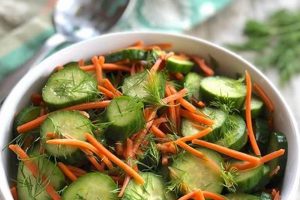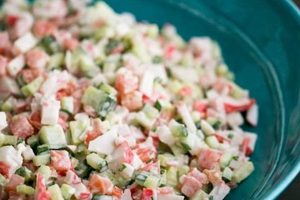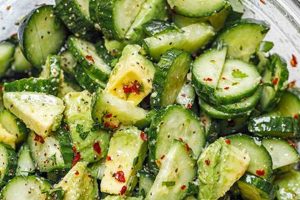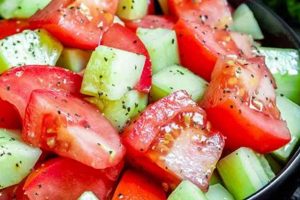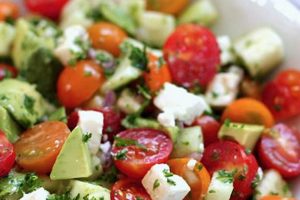A refreshing and hydrating dish typically combines cubed watermelon and cucumber, often with additions like feta cheese, mint, red onion, and a light vinaigrette. Variations may include other fruits, herbs, or spices. This simple summer salad offers a sweet and savory flavor profile with a satisfying crunch.
Such combinations provide a good source of hydration and essential nutrients. Watermelon contributes vitamins A and C, while cucumbers offer vitamin K and potassium. The optional ingredients further enhance the nutritional value. Historically, combining seasonal produce in simple salads has been a culinary practice across cultures, reflecting resourcefulness and an appreciation for fresh flavors. These dishes often become associated with warm-weather gatherings and celebrations.
The following sections will explore various aspects of creating this dish, including ingredient selection, preparation techniques, dressing options, and serving suggestions. Readers will gain a deeper understanding of how to prepare a delicious and visually appealing salad that is adaptable to individual preferences and dietary needs.
Tips for a Perfect Summer Salad
Creating a truly exceptional salad involves attention to detail and an understanding of how different elements contribute to the final result. The following tips offer guidance for achieving optimal flavor and presentation.
Tip 1: Select ripe, high-quality produce. A flavorful salad starts with the best ingredients. Choose a watermelon with a deep pink or red flesh and a hollow sound when tapped. Cucumbers should be firm and free from blemishes.
Tip 2: Chill ingredients before preparation. This enhances the refreshing quality of the salad and helps maintain its crispness.
Tip 3: Cut ingredients uniformly. Consistent sizing ensures even distribution of flavors and contributes to a visually appealing presentation. Consider using a melon baller for a unique touch.
Tip 4: Balance sweetness and acidity. Achieve a harmonious flavor profile by incorporating a slightly acidic element, such as lime juice or red wine vinegar, into the dressing.
Tip 5: Don’t overdress the salad. Too much dressing can make the salad soggy. Start with a small amount and add more as needed.
Tip 6: Add herbs and spices judiciously. Fresh mint, dill, or a pinch of chili flakes can elevate the flavor profile. Start with small quantities and adjust according to preference.
Tip 7: Serve immediately or chill briefly. While the salad can be prepared in advance, it’s best served fresh to maintain its optimal texture and flavor.
By following these tips, one can consistently create a vibrant and flavorful salad that showcases the peak of summer produce.
These guidelines offer a foundation for culinary exploration, encouraging experimentation and adaptation to individual tastes. The following conclusion summarizes the key elements of a successful preparation.
1. Fresh Ingredients
Fresh ingredients are paramount to a successful watermelon cucumber salad. The delicate, hydrating flavors of watermelon and cucumber are best showcased when the produce is at its peak ripeness. A less-than-fresh watermelon, for instance, can be mealy and lack sweetness, while a cucumber past its prime may taste bitter and have a mushy texture. The overall quality of the salad directly correlates to the quality of its core components. A flavorful salad relies on the inherent sweetness of ripe watermelon and the crisp, cool taste of fresh cucumber. Using subpar ingredients compromises the intended refreshing and vibrant nature of the dish. Consider a scenario where slightly overripe watermelon is used; the resulting salad may become watery and overly sweet, diminishing the intended balance of flavors. Conversely, using a cucumber that is not firm and crisp can detract from the textural contrast that contributes to a satisfying culinary experience.
Sourcing the highest quality produce elevates the simple combination of watermelon and cucumber. Farmers’ markets often offer superior options, allowing consumers to select produce based on aroma, texture, and appearance. This attentiveness to ingredient selection ensures optimal flavor and contributes to a more satisfying sensory experience. For example, choosing a watermelon with a deep, uniform color and a slightly hollow sound when tapped often indicates ripeness and sweetness. Similarly, opting for cucumbers that are firm to the touch and free from blemishes ensures a crisp and clean flavor. These practical selection strategies demonstrate the tangible impact of ingredient quality on the final dish.
Ingredient freshness directly impacts the overall culinary success of a watermelon cucumber salad. Prioritizing quality produce ensures that the dish delivers the intended refreshing flavors and satisfying textures. Understanding the relationship between ingredient freshness and the final product empowers individuals to make informed decisions when preparing this simple yet flavorful summer salad. While variations exist, the foundational principle remains: quality ingredients produce a quality dish. Overlooking this critical aspect can result in a disappointing culinary outcome, underscoring the importance of selecting the freshest produce available. This emphasis on ingredient quality carries over to other components, such as herbs and dressings, further emphasizing the interconnectedness of each element in achieving culinary excellence.
2. Precise Cutting
Precise cutting techniques play a crucial role in the overall success of a watermelon cucumber salad recipe. Uniformity in size and shape not only enhances the visual appeal of the salad but also contributes significantly to the balance of flavors and textures. Consistent cuts ensure that each bite provides a harmonious blend of watermelon and cucumber, along with other incorporated ingredients. This precision elevates the salad from a simple mix of ingredients to a carefully constructed culinary creation.
- Uniformity of Size:
Cutting ingredients into uniform pieces ensures even distribution of flavor and facilitates consistent cooking, if applicable. Imagine a fruit salad with large chunks of melon alongside tiny bits of grape; the larger pieces would dominate the flavor profile. In a watermelon cucumber salad, consistent sizing ensures a pleasant and balanced taste experience in each bite. This uniformity prevents one ingredient from overpowering another and creates a more harmonious blend of flavors. Additionally, it allows the dressing to coat the ingredients evenly.
- Shape Considerations:
The shape of the cut ingredients influences both the aesthetic presentation and the textural experience. Cubing the watermelon and cucumber creates a classic look and provides a satisfying crunch. Alternatively, using a melon baller for the watermelon can add an element of elegance and provides a slightly different mouthfeel. The choice of shape can be tailored to the overall aesthetic of the meal and the desired culinary experience. For instance, a more rustic presentation might call for larger, irregular chunks, while a formal setting might benefit from more precisely shaped pieces.
- Ease of Eating:
Precise cutting also impacts the ease of consumption. Pieces that are too large can be difficult to manage with a fork, while pieces that are too small can become lost in the mix. Thoughtful cutting techniques create a salad that is both enjoyable to eat and visually appealing. Consider a salad with oversized watermelon wedges; these would be challenging to eat gracefully. Conversely, overly small, diced pieces might make the salad feel less substantial. An appropriate size facilitates a pleasant dining experience.
- Visual Appeal:
Precisely cut ingredients contribute significantly to the overall presentation. A neatly arranged salad with uniformly sized and shaped pieces is more visually appealing than one with haphazardly chopped ingredients. This visual appeal enhances the dining experience and reflects the care taken in preparation. A well-presented salad can stimulate appetite and create a more enjoyable culinary experience. For example, a salad with neatly diced watermelon and cucumber, garnished with a few sprigs of fresh mint, is significantly more appealing than a bowl of unevenly chopped ingredients. This attention to detail elevates the simple salad to a more refined dish.
In conclusion, precise cutting is an essential aspect of creating a successful watermelon cucumber salad recipe. It influences not only the visual appeal but also the balance of flavors, textures, and overall dining experience. By understanding and applying these principles, one can elevate a simple summer salad to a culinary masterpiece. This attention to detail, from the selection of fresh ingredients to the precision of the cuts, transforms a basic dish into a more refined and enjoyable experience.
3. Flavor Balance
Flavor balance is paramount in a successful watermelon cucumber salad recipe. The inherent sweetness of ripe watermelon requires careful counterpoint to prevent the salad from becoming cloying. This balance is typically achieved through the addition of acidic and savory elements. The mild, refreshing cucumber provides a subtle textural and flavor contrast, but additional components are essential for a well-rounded flavor profile. A simple vinaigrette, often incorporating lime or lemon juice, introduces the necessary acidity to cut through the sweetness of the watermelon. Further complexity can be achieved through the addition of salty elements, such as feta cheese or a sprinkle of sea salt, and aromatic herbs like mint or dill.
The interplay of these contrasting flavors creates a dynamic and satisfying sensory experience. Consider the effect of omitting the acidic element: the salad would likely be perceived as overly sweet and lack the refreshing brightness that a well-balanced vinaigrette provides. Similarly, without a salty component, the sweetness of the watermelon might not be fully realized, and the overall flavor profile could fall flat. Real-life examples abound: a classic Greek salad, with its combination of tomatoes, cucumbers, olives, and feta, exemplifies the successful interplay of sweet, salty, and acidic flavors. In the context of a watermelon cucumber salad, a similar principle applies, albeit with a more delicate balance suited to the subtle flavors of the primary ingredients.
Understanding the importance of flavor balance empowers one to create a watermelon cucumber salad that transcends mere refreshment and becomes a truly enjoyable culinary experience. Challenges may arise in achieving this balance; for example, overzealous application of acidic elements could result in a salad that is too tart. However, through careful consideration of the interplay of sweet, salty, acidic, and aromatic components, one can confidently craft a salad that exemplifies the refreshing and vibrant nature of summer produce. This understanding translates into practical applications, enabling adjustments based on ingredient availability and personal preferences. The core principle remains consistent: a well-balanced flavor profile is crucial for a successful and satisfying watermelon cucumber salad.
4. Hydration
Hydration plays a critical role in overall well-being, impacting physical and cognitive functions. A watermelon cucumber salad recipe offers a palatable and effective means of contributing to daily fluid intake, particularly during warmer months when dehydration is a greater risk. This inherent hydrating quality distinguishes the salad from other dishes and contributes to its summertime appeal.
- Water Content:
Both watermelon and cucumber possess high water content. Watermelon, composed of over 90% water, provides a significant fluid boost. Cucumbers, similarly hydrating, contribute further to the salad’s overall water content. Consuming this salad can effectively replenish fluids lost through perspiration, particularly valuable during physical activity or in hot climates. This inherent hydration distinguishes the salad from denser, less hydrating dishes.
- Electrolyte Replenishment:
While primarily water, watermelon and cucumber also contain electrolytes, such as potassium and magnesium, lost through sweat. These electrolytes play essential roles in maintaining fluid balance, muscle function, and nerve signaling. The inclusion of these electrolytes enhances the salad’s hydrating properties, promoting efficient fluid absorption and retention. This feature makes the salad a more comprehensive hydrating option compared to plain water.
- Enhanced Absorption:
The combined consumption of water-rich produce with other ingredients, such as a small amount of salt or electrolytes in a dressing, can facilitate more effective fluid absorption. This synergy optimizes hydration, contributing to overall well-being. Contrast this with drinking plain water, which, while hydrating, may not be absorbed as efficiently without the presence of electrolytes. This enhanced absorption further strengthens the salad’s position as a valuable hydrating food.
- Dietary Impact:
Incorporating a hydrating salad into one’s diet promotes fluid intake without relying solely on beverages. This approach can be particularly beneficial for individuals who struggle to consume adequate water throughout the day. The salad offers a flavorful and nutrient-rich alternative, contributing to overall hydration goals. This aspect distinguishes the salad as a valuable dietary component, exceeding its simple categorization as a side dish.
The hydrating properties of a watermelon cucumber salad represent a significant benefit, particularly in warmer climates or during periods of increased physical activity. The high water content of both primary ingredients, combined with the potential for electrolyte replenishment and enhanced fluid absorption, makes this salad a valuable contribution to overall hydration strategies. This inherent hydration distinguishes the dish from other salads and contributes to its recognized health benefits. This focus on hydration complements the other positive attributes of the salad, further solidifying its status as a nutritious and refreshing culinary choice.
5. Visual Appeal
Visual appeal significantly enhances the perceived value and enjoyment of a watermelon cucumber salad recipe. Presentation elevates this simple dish from a basic combination of ingredients to a visually engaging culinary experience. Careful consideration of color, texture, and arrangement transforms the salad into an appetizing centerpiece or a refreshing side dish.
- Color Contrast:
The vibrant colors inherent in watermelon and cucumber provide a natural foundation for visual appeal. The deep red or pink of ripe watermelon contrasts beautifully with the cool green of cucumber, creating an immediate visual interest. This inherent color contrast can be further amplified by the addition of other ingredients. For example, incorporating feta cheese introduces a bright white element, while a sprinkle of fresh herbs like mint or dill adds a touch of vibrant green. Consider a salad composed solely of pale watermelon and cucumber; while refreshing, it might lack the visual vibrancy achieved by incorporating deeper hues.
- Textural Variety:
Visual appeal extends beyond color to encompass textural variety. The smooth, juicy texture of watermelon juxtaposed with the crisp, slightly rough texture of cucumber creates a visually appealing contrast. This textural interplay is further enhanced by the optional inclusion of ingredients such as crumbled feta cheese or toasted nuts, which introduce additional layers of visual and tactile interest. Imagine a salad with uniformly smooth ingredients; while palatable, it might lack the visual dynamism created by contrasting textures.
- Arrangement and Plating:
The arrangement and plating of the salad contribute significantly to its visual appeal. A simple yet effective approach involves arranging the watermelon and cucumber pieces in an alternating pattern, creating a visually balanced and organized presentation. A more elaborate arrangement might involve layering the ingredients, creating height and depth. The choice of serving dish also plays a role; a clear glass bowl showcases the vibrant colors of the salad, while a rustic wooden bowl adds a touch of natural elegance. Consider the difference between a salad haphazardly tossed into a bowl and one carefully arranged on a platter; the latter clearly demonstrates greater attention to visual detail.
- Garnishing Techniques:
Thoughtful garnishing elevates the visual appeal of the salad. A simple sprig of fresh mint or a sprinkle of feta cheese can transform a basic presentation into a more refined and visually engaging dish. Garnishes should complement the existing colors and textures, enhancing the overall visual harmony. A scattering of toasted sesame seeds, for example, adds a subtle textural and visual element without overwhelming the other components. Consider the impact of an overly elaborate garnish; it could detract from the natural beauty of the salad’s core ingredients.
The visual appeal of a watermelon cucumber salad enhances the overall dining experience. By considering the interplay of color, texture, arrangement, and garnishing techniques, one can transform this simple salad into a visually captivating dish. This attention to presentation elevates the salad from a mere side dish to a more engaging and enjoyable culinary creation, underscoring the significant role of visual appeal in the perception and appreciation of food.
6. Nutritional Value
Nutritional value represents a significant benefit within a watermelon cucumber salad recipe. This dish offers more than just refreshment; it provides a readily available source of essential vitamins, minerals, and antioxidants. Understanding this nutritional profile allows for informed dietary choices and highlights the role of this simple salad in contributing to overall health and well-being. This nutritional contribution distinguishes the salad from less nutrient-dense options, solidifying its place as a healthful dietary component.
Watermelon, a key ingredient, contributes significant amounts of vitamins A and C. Vitamin A supports vision and immune function, while vitamin C acts as a potent antioxidant, protecting cells from damage. Cucumber, though lower in calories, provides vitamin K, essential for blood clotting, and potassium, an electrolyte crucial for fluid balance and muscle function. The combined nutritional profile of these two core ingredients creates a synergistic effect, offering a broader spectrum of nutrients than either ingredient alone. Consider, for example, the impact of adding feta cheese to the salad: this introduces a source of calcium and protein, further enhancing the nutritional value. Conversely, opting for a high-calorie, high-fat dressing could diminish the overall health benefits. Practical application of this nutritional understanding allows for informed ingredient choices and portion control.
The inherent nutritional value of a watermelon cucumber salad underscores its role as a healthful dietary component. This understanding empowers informed choices, aligning food consumption with health goals. Challenges may arise in maintaining nutritional integrity; for instance, excessive use of sugary dressings can negate some of the inherent health benefits. However, mindful ingredient selection and preparation methods can mitigate these challenges, ensuring the salad remains a nutrient-rich option. Integrating this salad into a balanced diet exemplifies a proactive approach to health management, highlighting the practical significance of understanding nutritional value in everyday food choices.
7. Seasonal Relevance
Seasonal relevance significantly impacts the perceived value and enjoyment of a watermelon cucumber salad recipe. Both watermelon and cucumber are quintessential summer crops, reaching peak flavor and availability during warmer months. This alignment with the natural growing season enhances the culinary experience, as ingredients harvested at their peak ripeness offer superior taste and nutritional value. Consuming a watermelon cucumber salad during its peak season connects diners to the natural rhythm of food production, fostering an appreciation for fresh, locally sourced ingredients. Conversely, attempting to prepare this salad using out-of-season produce often results in a diminished culinary experience, as the ingredients may lack flavor, texture, and nutritional potency. For example, a winter watermelon, grown in a different climate and potentially harvested prematurely, will likely lack the sweetness and juiciness of a summer watermelon ripened on the vine. This underscores the importance of seasonality in achieving optimal flavor and quality.
This connection to seasonality extends beyond mere flavor. The availability of fresh, local produce reduces transportation costs and environmental impact, supporting sustainable agricultural practices. Farmers’ markets often showcase the bounty of each season, providing opportunities to select the freshest, most flavorful ingredients for a watermelon cucumber salad. Choosing locally sourced ingredients strengthens community ties and supports local economies. Furthermore, seasonal eating promotes dietary diversity, encouraging exploration of a wider range of fruits and vegetables throughout the year. For example, incorporating seasonal berries into the salad during their peak availability adds another layer of flavor and nutritional value while aligning with the principles of seasonal eating. This adaptability allows the basic recipe to evolve throughout the summer, reflecting the changing availability of different produce.
Seasonal relevance is integral to a truly satisfying watermelon cucumber salad experience. Prioritizing seasonal ingredients elevates the flavor profile, nutritional value, and overall culinary experience while supporting sustainable practices. Challenges may arise in accessing specific ingredients outside of their peak season; however, understanding the significance of seasonality encourages adaptability and exploration of alternative seasonal produce. This awareness reinforces a conscious connection between food consumption and the natural world, promoting a deeper appreciation for the cyclical nature of agricultural production and its impact on culinary practices. Ultimately, aligning food choices with seasonal availability enhances both the individual dining experience and the collective well-being of the food system.
Frequently Asked Questions
This section addresses common inquiries regarding watermelon cucumber salad recipes, offering concise and informative responses to facilitate successful preparation and enjoyment.
Question 1: How long can this salad be stored?
While best consumed immediately, the salad can be refrigerated for up to two days. However, some textural changes may occur due to the high water content of the ingredients.
Question 2: Can other ingredients be added?
Variations are encouraged. Feta cheese, red onion, mint, and other herbs complement the core ingredients. Other fruits, such as berries or grapes, can also be incorporated, but consider their impact on the overall flavor profile.
Question 3: What type of dressing is recommended?
A light vinaigrette complements the delicate flavors of the salad. Lime or lemon juice, olive oil, and a touch of salt and pepper create a simple yet effective dressing. More complex dressings can incorporate herbs, spices, or a touch of honey or maple syrup.
Question 4: Can the salad be prepared in advance?
Advance preparation is possible, but best results are achieved when the salad is assembled shortly before serving. If preparing in advance, store the dressing separately and combine just before serving to maintain optimal texture.
Question 5: How can excess moisture be minimized?
Salting the cut watermelon and cucumber and allowing them to drain for a short period before combining with other ingredients can help reduce excess moisture and maintain a crisp texture.
Question 6: What are the key nutritional benefits?
This salad is a good source of vitamins A and C from watermelon, as well as vitamin K and potassium from cucumber. It is also a hydrating and low-calorie dish, making it a healthy dietary choice.
Careful ingredient selection, precise cutting techniques, and a balanced flavor profile contribute to a successful watermelon cucumber salad. Adaptability and experimentation are encouraged to cater to individual preferences.
The following section offers a collection of recipe variations to further inspire culinary exploration.
Watermelon Cucumber Salad Recipe
Exploration of watermelon cucumber salad recipes reveals a dish characterized by simplicity, freshness, and adaptability. Key elements include the importance of fresh, high-quality ingredients, the impact of precise cutting techniques on both visual appeal and flavor balance, and the essential role of hydration in contributing to the salad’s refreshing quality. Nutritional value and seasonal relevance further enhance the dish’s appeal, positioning it as a healthful and seasonally appropriate culinary choice. Adaptability to individual preferences through variations in ingredients and dressings expands the potential of this simple salad, allowing for personalized culinary expression.
Culinary exploration of this seemingly simple dish reveals a depth of consideration extending beyond mere ingredient combination. Attention to detail, from ingredient selection to presentation, elevates the watermelon cucumber salad to a culinary expression worthy of appreciation. This exploration encourages further experimentation and adaptation, prompting continued evolution and refinement of this versatile and refreshing dish.

